Before we show you Ben’s solution, let’s remind ourselves of the challenge he was posed.
The Premier League has finally decided to listen to @RomeluLukaku9’s request to play a North vs South All-Star match. The FA appointed Brendan Rodgers as the coach for Team North.
*Please read the disclaimer at the bottom of the tread before being upset about our N/S divide.
— Total Football Analysis (@TotalAnalysis) April 6, 2020
The Premier League have appointed Brendan Rodgers to manage the North of England in a one-off game against the South. I, meanwhile, must pick from the ten assigned southern teams to face Rodgers’ starting eleven, selecting at least one player from each team. It is expected that Rodgers will stick to his philosophy play his preferred style of play using tactics that we have seen his Leicester City side be so successful with in recent times.
Lineups
Team North XI (4-3-3): Martin Dúbravka, Lucas Digne, Virgil van Dijk, James Tarkowski, Aaron Wan-Bissaka, Wilfred Ndidi, Bruno Fernandes, Kevin De Bruyne, Jack Grealish, Lys Mousset, Adama Traoré
Team South XI (4-3-3): Vicente Guaita, Bukayo Saka, Nathan Aké, Issa Diop, Reece James, Pierre-Emile Højbjerg, Aaron Mooy, Abdoulaye Doucouré, Son Heung-min, Harry Kane, Emi Buendía


Defensive structure
Out of possession, Team South will be adopting an aggressive high-pressing structure. The reasoning behind this decision is that Team North have a very technical midfield, so we want to prevent them from having any time or space on the ball. Furthermore, Team North have a distinct lack of height up front, so will struggle to retain possession should they be forced to go long. For example, their striker, Lys Mousset, has won just 24% of his aerial duels this season.

First, we must discuss how Rodgers is likely to set up his team in possession. In the initial phases of build-up, he tends to instruct the wide forwards to stay wide. As a result of this, spaces open up in the inside channel for the two advanced midfielders to receive the ball, as shown above. As soon as they receive the ball, they will try to play on the half-turn and immediately feed one of the front three. With the threat in-behind that Mousset and Traoré provide and the quality of pass that both Fernandes and De Bruyne possess, we want to prevent this action from occurring.

Above shows how we, Team South, will set up to press Team North high up the pitch. Our structure is similar to how Liverpool set up to press Leicester in their 4-0 away win earlier this season. This system involves a combination of zonal and man-orientated pressing in order to be as compact as possible in the centre of the pitch, where we want to deny the opposition time and space. Since Rodgers likes to build up with his fullbacks high and wide, we want our wide forwards to be positioned between the full-back and centre-back. What this allows Buendía and Son to do, is to press the opposition centre-backs when they are in possession while keeping their respective full-backs in their cover-shadows. Using this technique allows us to block wide passing lanes with as few players as possible, thus enabling us to maintain numerical superiority in the centre of the pitch. Kane will be instructed to stay tight on Ndidi, their lone pivot, apart from certain moments where he will situationally press either of the two centre-backs or the goalkeeper. He must make sure Ndidi is not able to receive the ball with time to turn and face forwards, thereby preventing central progression via the pivot. However, if either wide forward is at any point unable to step up to press the centre-back, Kane would be permitted to press the centre-back and keep Ndidi in his cover-shadow. In particular, it is essential that either Kane or Buendía is pressing the left centre-back, Van Dijk, whenever he receives the ball, due to his fantastic passing range.
Our two advanced midfielders, Mooy and Doucouré, must then be tight on De Bruyne (Manchester City) and Fernandes (Manchester United) respectively. This will prevent them from being able to receive on the half-turn and play the ball in-behind to any of their front three. The other job that our central midfielders have is to press the opposition full-backs if they ever manage to receive the ball behind either of our wide forwards, although this should be a rare occurrence since Dúbravka has a poor long pass completion rate. However, we still don’t want either De Bruyne or Fernandes to be able to receive in space once either of our midfielders has stepped out to press, so while pressing, they must keep their assigned midfielder in their cover-shadow. Our lone pivot, Højbjerg, is then able to zonally mark the space in between the midfield and defensive lines, as displayed above. This role is vital, as he is able to step up situationally to press either midfielder should they manage to ever find space in the inside channel where they are most effective. He also acts as the base of our central diamond, creating a 4v3 against the opposition’s midfield and decreasing the risk of them finding a free man in midfield through quick passing combinations.

One danger that Team North pose is Grealish dropping into the inside channel from his wide position on the left to receive the ball in between the lines. To prevent him from receiving the ball in space, we will instruct Reece James to stay tight and follow him infield. However, as demonstrated above, the danger of this is that it leaves a large space in our defensive line in the area that James vacated. To cover this space, Højbjerg can come across to block the potential overlap from Digne.
I believe that this team should be able to perform this pressing system well, as they are all capable pressers that should be able to sustain the intensity over the course of the 90 minutes. Our defensive personnel also possess the attributes required to maintain a high defensive line, as they are quick enough to recover should a ball be played behind them into one of the opposition’s front three.
Offensive transition
One of the vulnerabilities of Rodgers’ offensive structure is that many of his players are positioned high up the pitch. For example, he likes his full-backs to be positioned high and wide to stretch the opposition laterally. The disadvantage of this for the opposition is that if they lose the ball, especially when close to their own goal, large spaces in and around their own penalty box can be exploited.

As displayed above, Team North’s offensive structure leaves large spaces either side of the centre-backs. These spaces will likely become even larger as the centre-backs will look to immediately move centrally once the ball is lost to cover the space in front of their own goal.

As highlighted in the above graphic, our pressing structure allows us to have a momentary 3v2 on the opposition’s centre-backs after winning the ball back. Since Rodgers will try to get his team to play through the midfield via the two advanced midfielders, our 4v3 in midfield will allow us to frequently win the ball in the central area of the pitch, often with either Mooy or Doucouré winning back possession. As soon as they do so, they should look to play a pass into Højbjerg who will be free of immediate pressure since he is not man-marking any opposition player. In this pocket of space, Højbjerg will then be able to receive facing forwards and play a pass directly into the run of any of the front three. This will allow us to consistently create chances on offensive transition.
Attacking structure

The image above exhibits how we will want to organise ourselves in the first phase of build-up. Since Rodgers seems to prefer his wide players to stay close to the opposition full-backs, this often leaves the striker to press both centre-backs as well as block any passing lanes to the pivot. Utilising the composure of Aké in possession, we can play around Mousset’s pressure by passing around him in the diamond that we’ve created in front of our goal. This should be relatively comfortable since it is a 4v1 situation. Once the ball has reached Højbjerg, one of their central midfielders, either De Bruyne or Fernandes, will step out to press him to prevent him from having time to turn and play forwards.

In this above example, we see that Fernandes has left Doucouré to close down Højbjerg. Højbjerg can then play it back to the centre-back on the side of the central midfielder that is free, in this case, our right side. The centre-back can now play a vertical pass to our ball-near central midfielder who should make a short lateral movement to the outside in order to make sure that he is free.

As our central midfielder is turning forwards into space, the wide forwards should make runs in between the opposition centre-backs and fullbacks to force their backline to become narrower.

This would then leave large spaces for our overlapping fullbacks to receive the ball in, and suddenly we have a 5v4 on the opposition backline, assuming Ndidi steps up to press Doucouré to prevent him from carrying the ball up the pitch. This sequence is how we can create chances by playing through the press.
Since our plan is to press high up the pitch, we can expect to have periods where the team are in control of possession in their half with Team North organised in a compact 4-5-1 block.
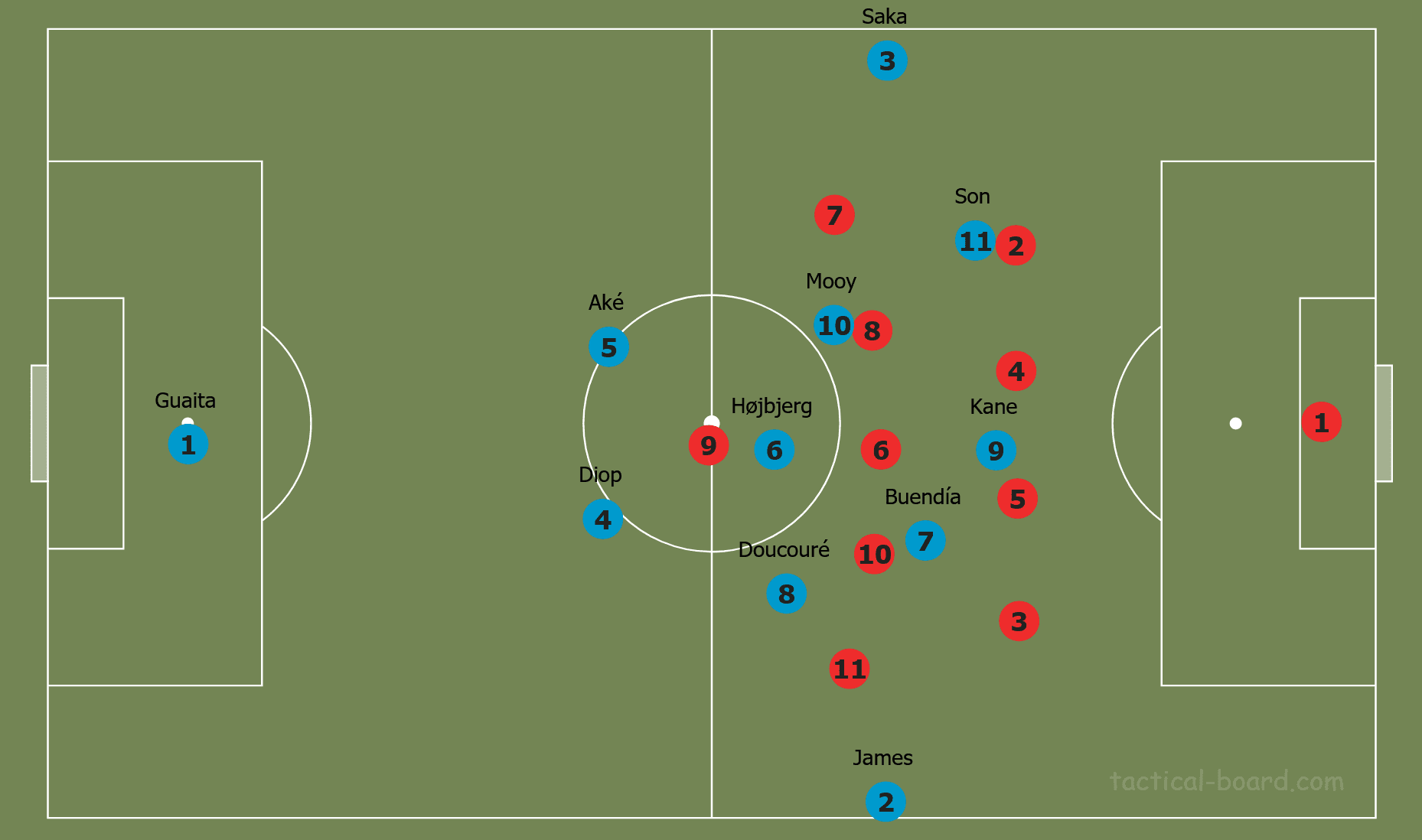
The image above exhibits how we will be organised in possession in their half of the pitch. As shown, our set-up will be asymmetric in order to make use of the best qualities of our team.

This graphic displays how Buendía and Doucouré can create a 2v1 against Fernandes on the right side. Ndidi (number six) cannot come over to support Fernandes since he is blocking the passing lane to Kane, as well as staying close to Højbjerg so that he can press him should he receive the ball. Meanwhile, Grealish (number 11) is focussed on cutting the passing lane to James. Digne cannot stay tight on Buendía as doing so would leave a huge gap out wide to be exploited by a run from James. Doucouré should then rotate deep, as shown, to be level with Højbjerg. This creates the space for Buendía to drop into between the lines. Fernandes now has a dilemma.
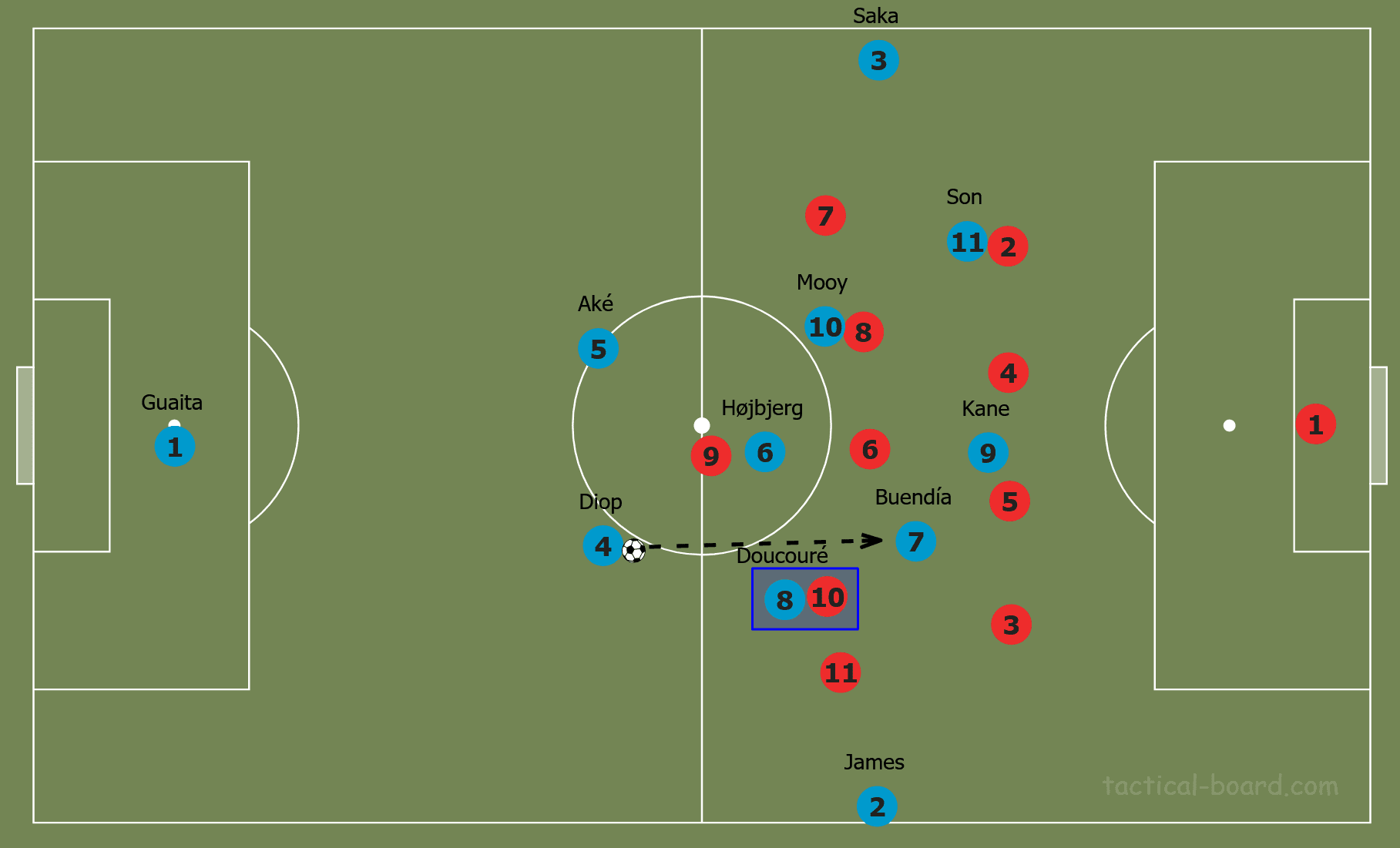
Either he can step out to stop Doucouré from receiving the ball from our centre-back, but leave the passing lane to Buendía completely open, as demonstrated above.
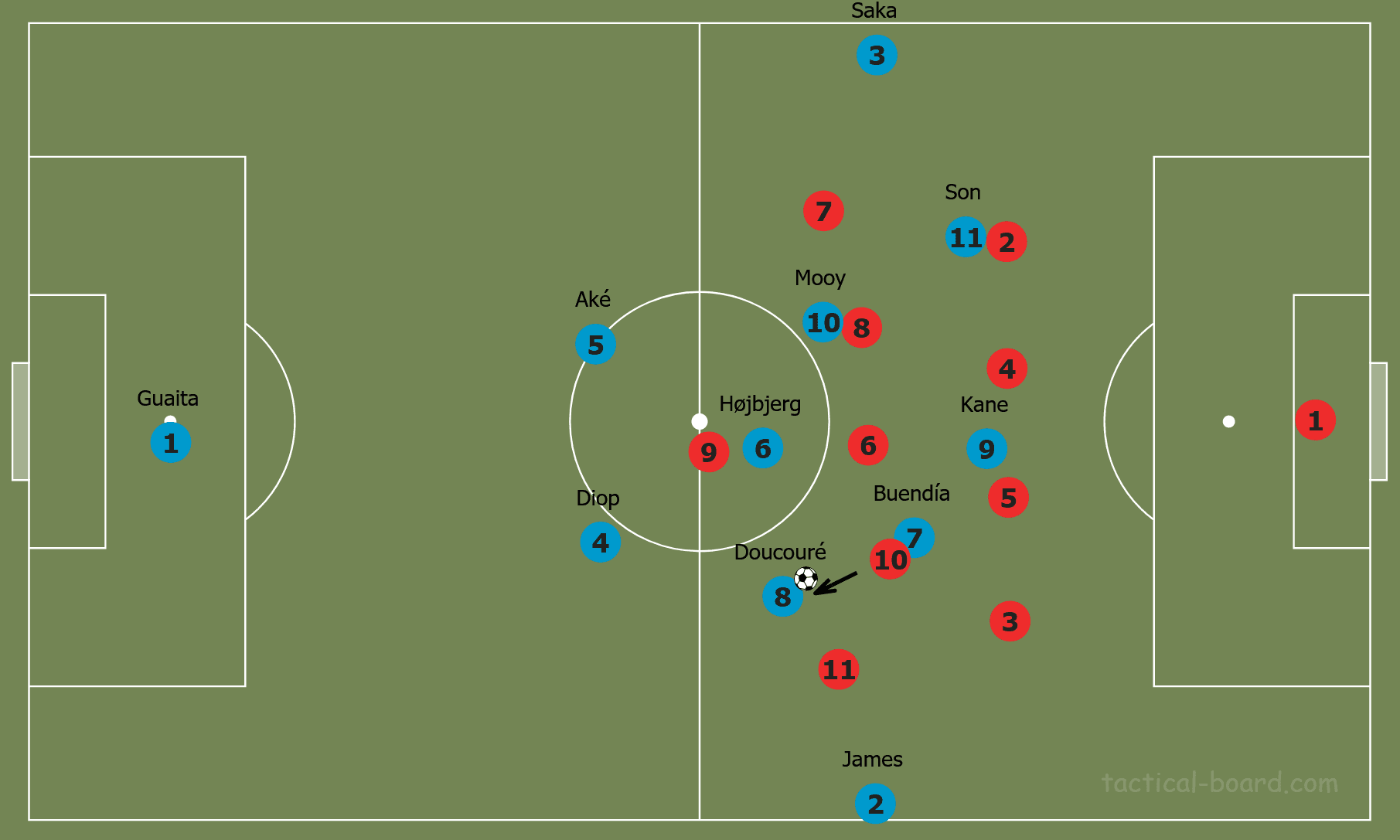
Or, he can block the passing lane to Buendía, and wait for Doucouré to receive the ball before pressing him.
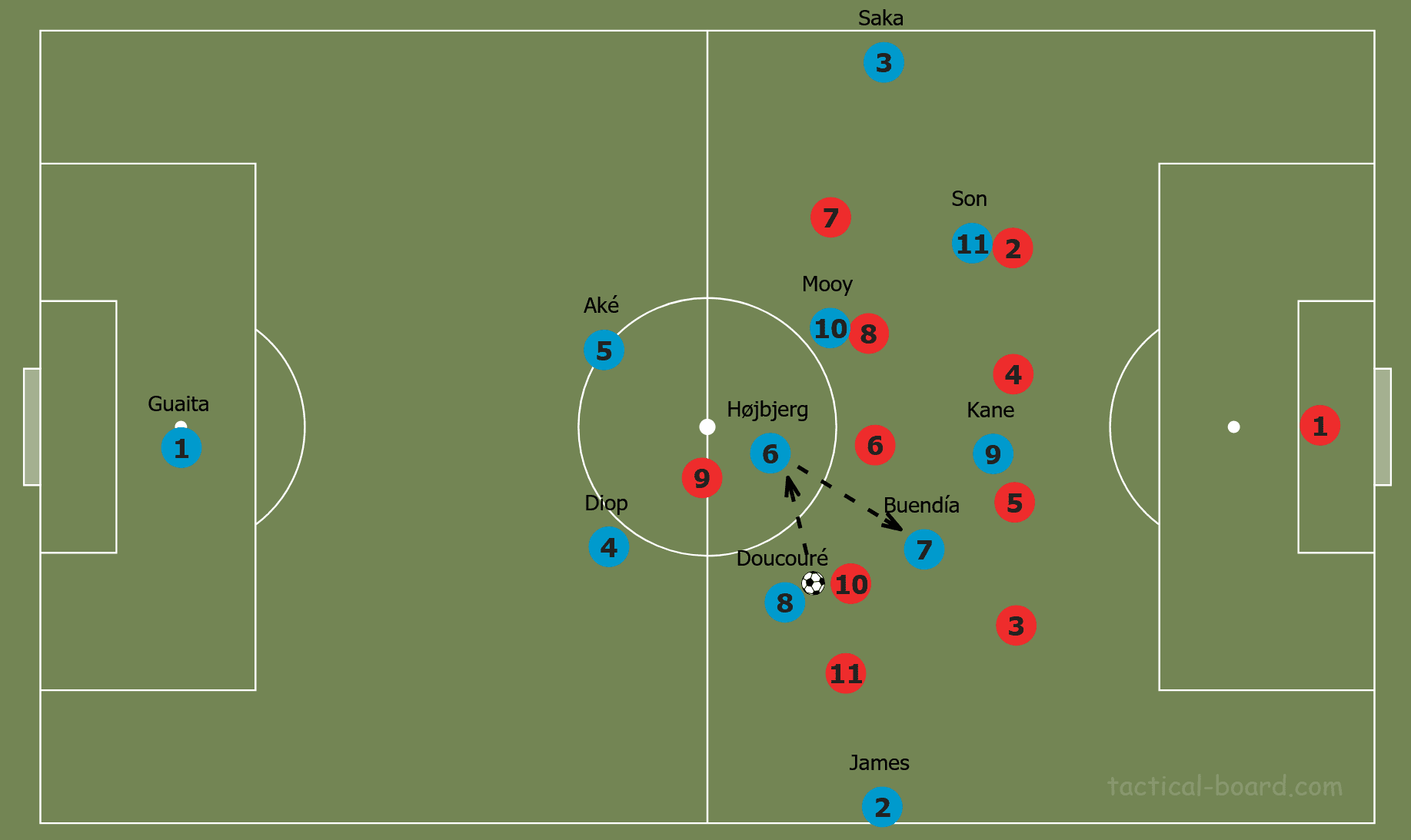
Doucouré can then play a lateral pass into Højbjerg, who will be free since Mousset will have stepped up slightly to press Diop. Højbjerg should next play a pass to Buendía who is free between the lines.
As discussed, both of these events lead to Buendía being free between the lines in the inside channel. Now we must discuss how we can create chances from this favourable position.
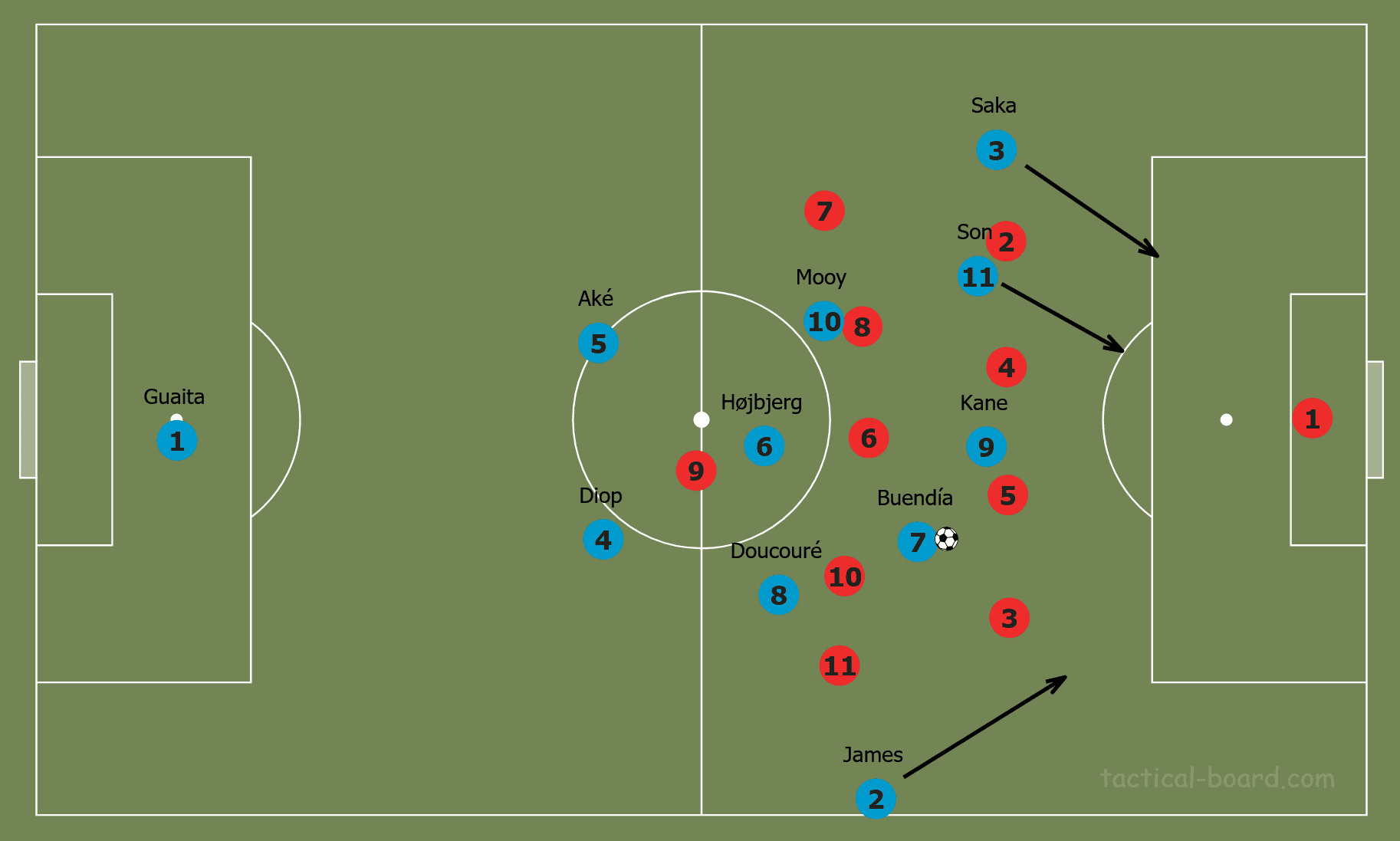
To stop Digne from stepping forward to close down Buendía, James should make an overlapping run to pin him. Meanwhile, Son should make a run on the blindside of Tarkowski, while Saka should make a run on the blindside of Wan-Bissaka. Buendía has the ability to play a lofted pass into the run of either of these players. If for whatever reason these runs aren’t made, Buendía could play a pass to his right into the path of the supporting run of James. With the quality of cross that James possesses, chances can easily be created for the likes of Kane and Son making runs into the box.
Conclusion
As discussed in this tactical analysis, the key to beating Team North is for us to utilise tactics that prevent them from having any time or space in midfield where their quality can hurt us. Our ability to create a free man in midfield can help us bypass their press, while our asymmetric structure in their half of the pitch can help us free Buendía between the lines. If these instructions are performed well, this analysis demonstrates that we should be able to create a higher quantity and quality of chances than Team North.






Comments